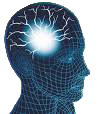Is your brain hot enough!
Neuroscientific research and new therapeutic applications are developing rapidly these include transcranial magnetic stimulation, cranial electrotherapy stimulation, infrared Hemoencephalography pIR,EEG biofeedback and several other neuromodulation devices/approaches (with variable evidence/research support).
Two therapies that I have found helpful in the clinic to treat headache and migraine are EEG biofeedback and Hemoencephalography pIR. It is the latter of these which is described below.
Infrared HEG pIR
When the brain focuses on a task, the part of the brain engaged in that task needs more energy, which uses more oxygen. This increased need for oxygen is met by more oxygen-rich blood being carried to that part of the brain. Thus there is a relationship between metabolic/nerve activity of the brain and blood flow.
Now, it has been shown using fMRI, SPECT and other brain imaging techniques that some migraineurs (and chronic headache sufferers) have asymmetrical and/or reduced metabolic activity- & associated reduced blood flow- in the prefrontal cortex (the part of the brain behind the forehead).
Recent research has suggested that if you can encourage the neurological activity, and thus the blood flow, in the prefrontal cortex it results in reduced migraines/headaches.
One non-invasive/passive way of doing this is the Hemoencephalography (HEG) pIR, which is a device that measures the temperature of the frontal cortex (& thus the metabolic activity/ blood flow) via infrared technology.
Using sophisticated computer software this information can provide feedback that encourages the brain to increase metabolic activity/ blood flow to the prefrontal cortex, which usually leads to improved & more balanced functioning.
i.e by using techniques that ‘teach’ the brain how to increase & regulate neurological activity / blood flow it is then able to do it’s job better and more efficiently.
HOW DOES IT WORK?
HEG pIR consists of a headset with three sensors built-in, which measures the temperature/blood flow of the prefrontal cortex(PFC) via infrared technology. This headset is linked to a computer with a program that may, for example, play a DVD. Parameters are set so that the DVD will only work when the temperature/blood flow of the PFC is symmetrical.
Experience has shown that the brain quickly learns that in order to make DVD work it has to increase the temperature/blood flow in the underperforming areas of the PFC. It can only do this by activating more nerves and it seems that once these nerves are ‘switched back on’ they are more likely to stay activated and perform in a ‘regulated’ way. Thus the feedback ‘training’ encourages an evenly active PFC that in many cases results reduced symptoms.*
Research with pIR has focused almost exclusively on alleviating tension headaches and migraines. A four-year study of 100 chronic migraine sufferers found that after as few as six 30-minute training sessions, 80% of patients reported significant improvements with their migraines.
However, interestingly HEG has also shown promise at alleviating depression, stress and chronic anxiety.
*N.b. Improved neurological activity results in increased temperature, however the reverse is not the case, so please do not attempt to cure your migraine with a hot water bottle on your forehead!
Additional Resources
Passive Infrared Hemoencephalography, 4 Years and 100 Migraines, by Jeffrey A. Carmen
Hemoencephalography: A New Form of Neurofeedback, by Glen Blackett
Passive Infrared Hemoencephalography (pIR HEG), by Jeffrey A. Carmen
Self-Control for Migraine Headaches: Learning from Yoda, by Al Collins, Ph.D.
New Developments in blood flow Hemoencephalography, by Tim Tinius, Ed.
Basic introduction to pIR HEG Physiology and Method
Website of Dr. Jeffrey A. Carmen, the developer of pIR-HEG
Association for Applied Psychophysiology and Biofeedback.
www.york-biofeedback.co.uk/…/hemoencephalography_neurofeedback….
Also see ; Amen,D. & Routh, L. (2003). Healing anxiety and depression. Putnam: New York

